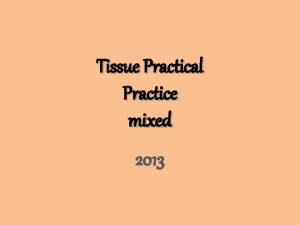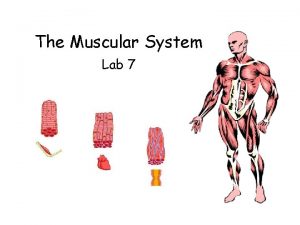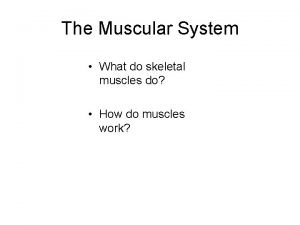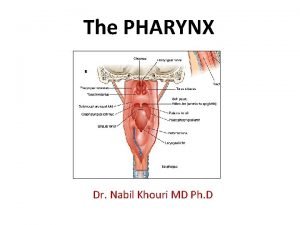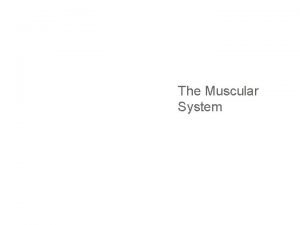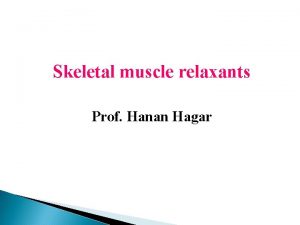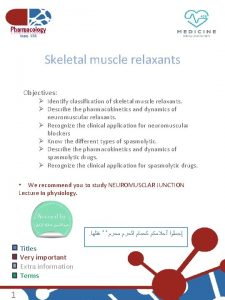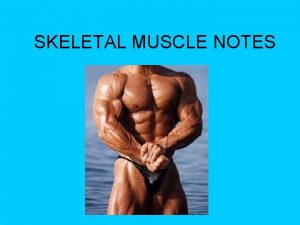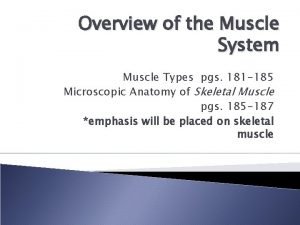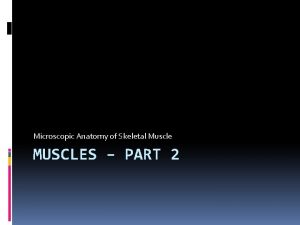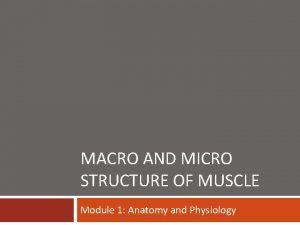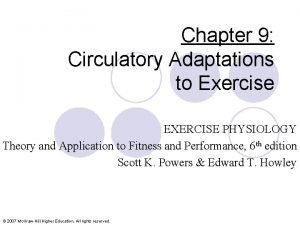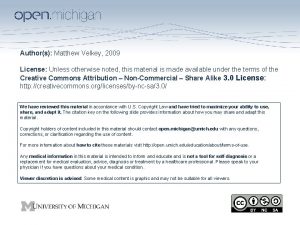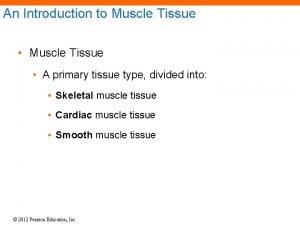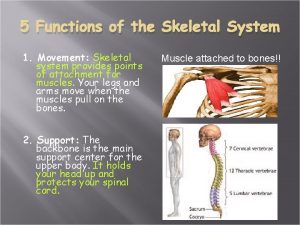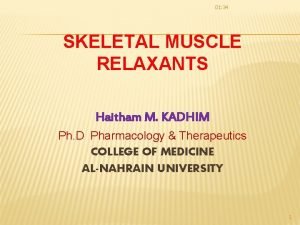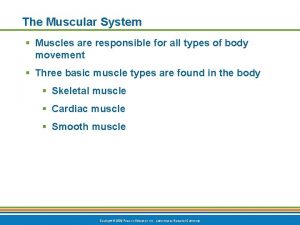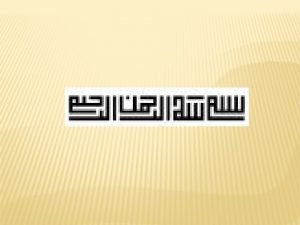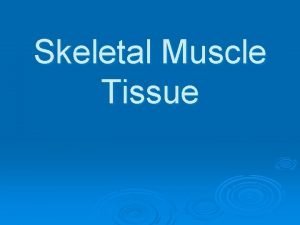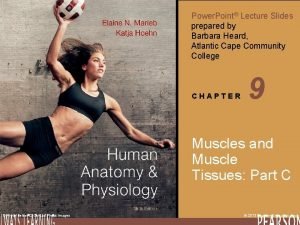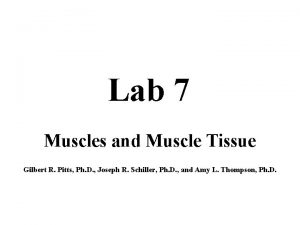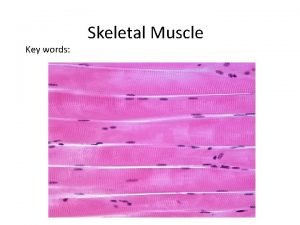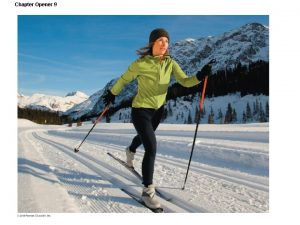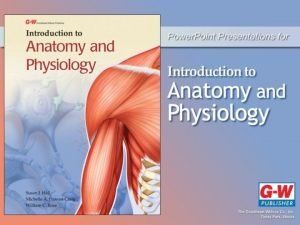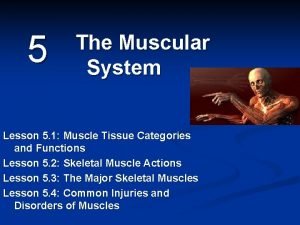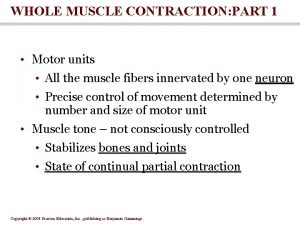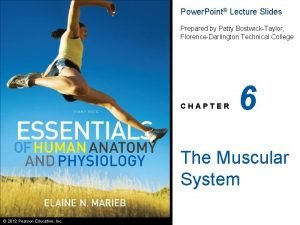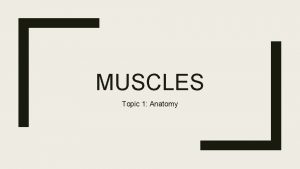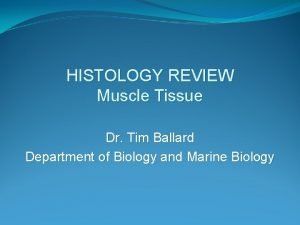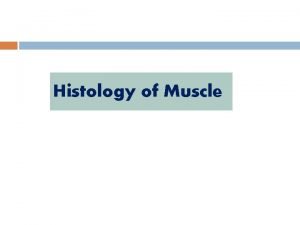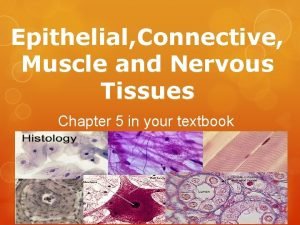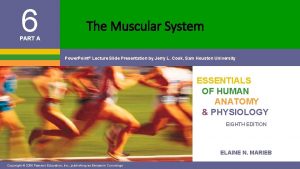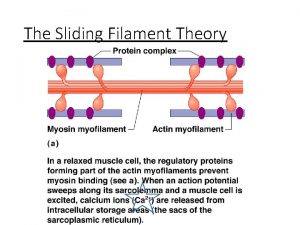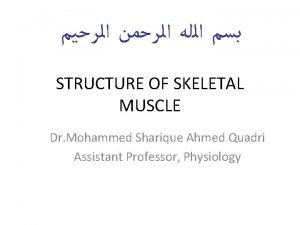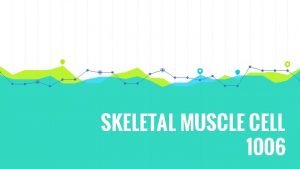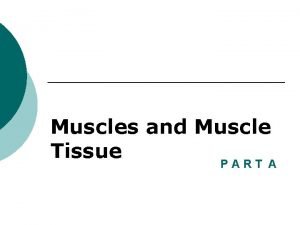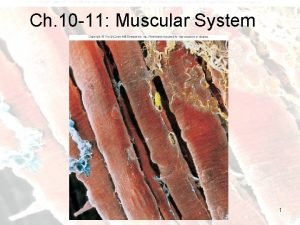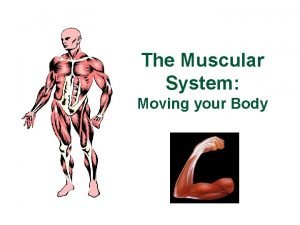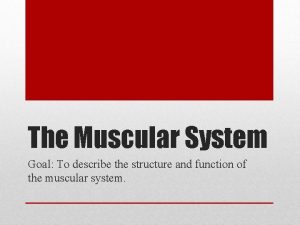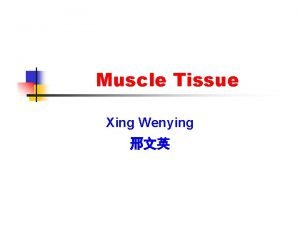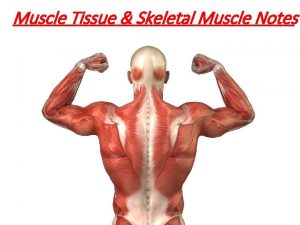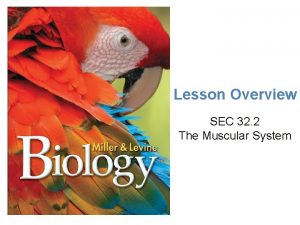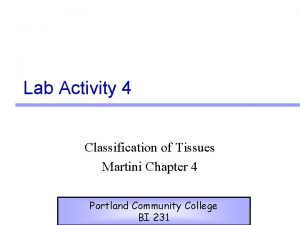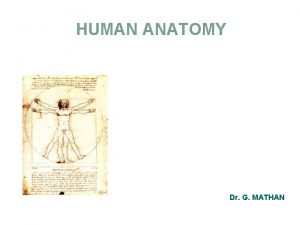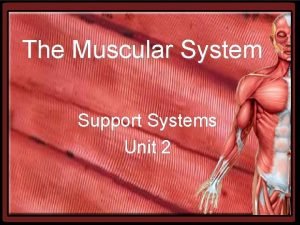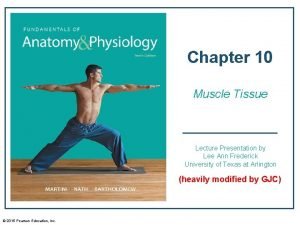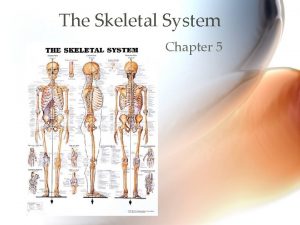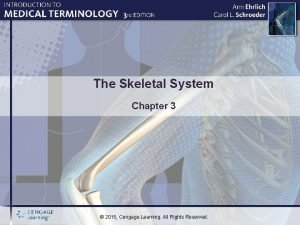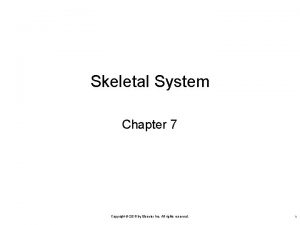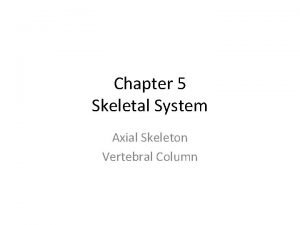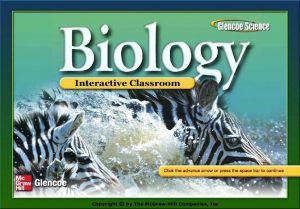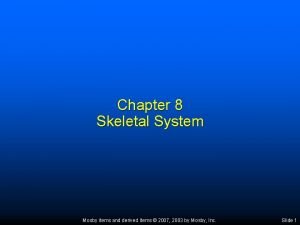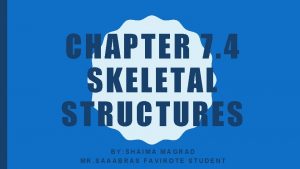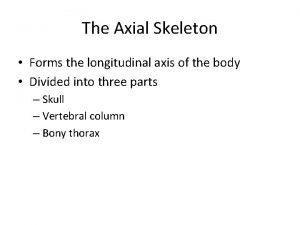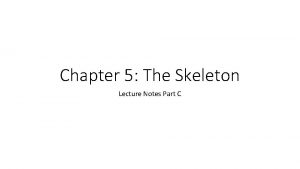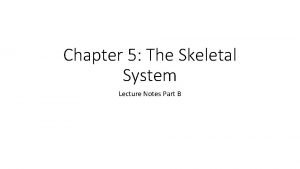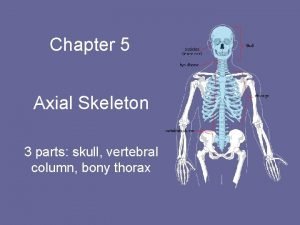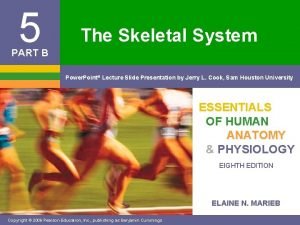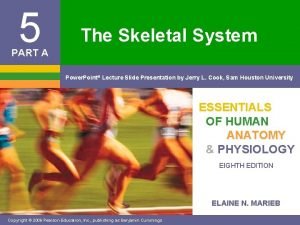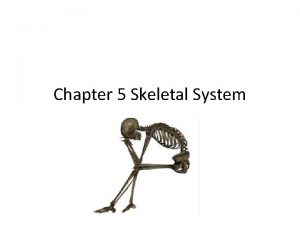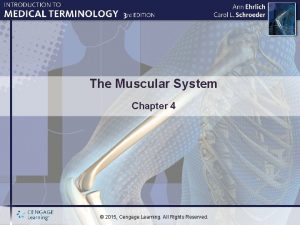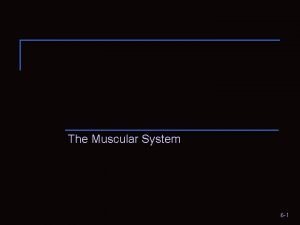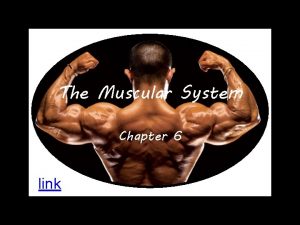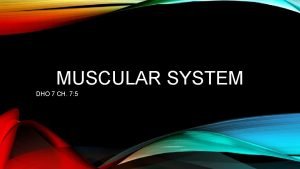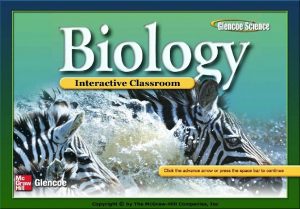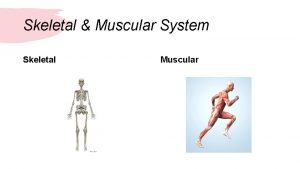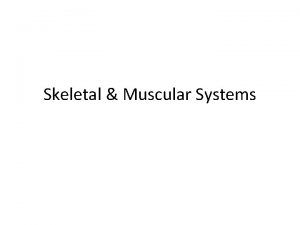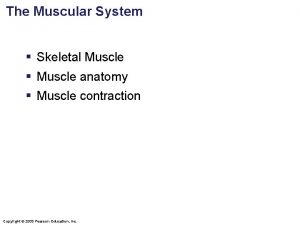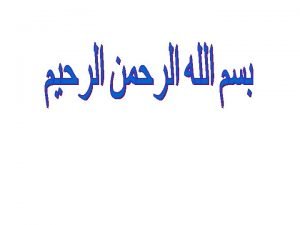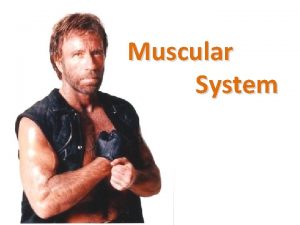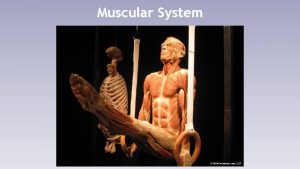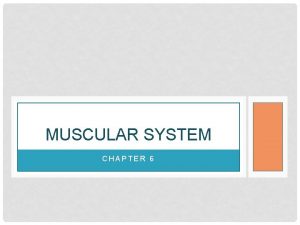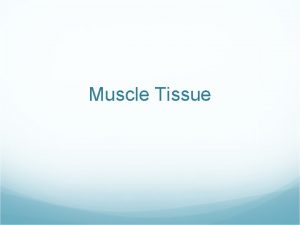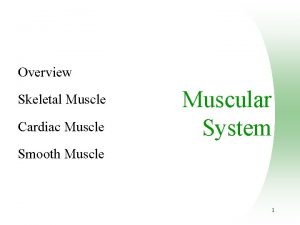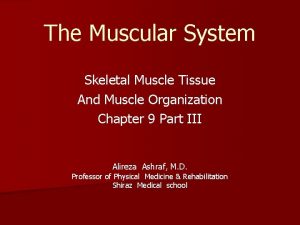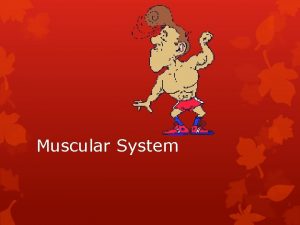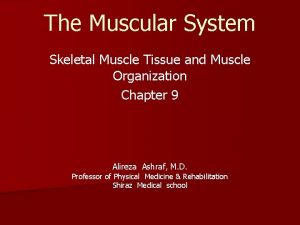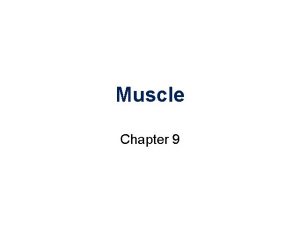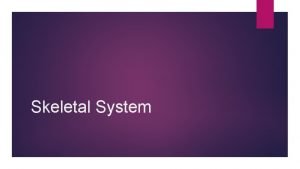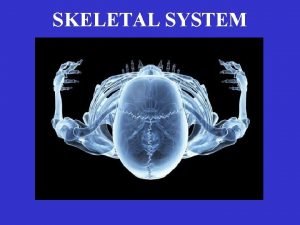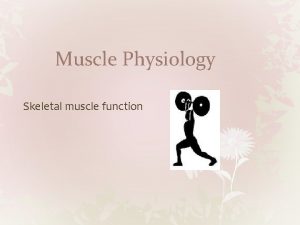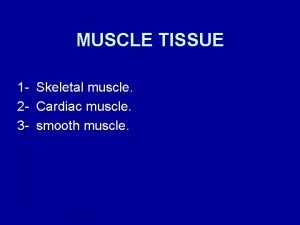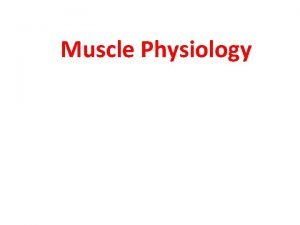MUSCULAR SYSTEM CHAPTER 6 MUSCLE CELL TYPES Skeletal





























































































- Slides: 93

MUSCULAR SYSTEM CHAPTER 6

MUSCLE CELL TYPES • Skeletal (striated) • Cardiac • Smooth (non-striated)

SIMILARITIES AMONG MUSCLE CELLS • All elongated • All called muscle fibers • All have myofilaments ( muscle’s ability to contract) • Prefixes- myo, mys, sarco ( all refer to muscle)

SKELETAL MUSCLE

SKELETAL MUSCLE • Attach to the body’s skeleton • Help form smooth contours of the body • Cigar-shaped • Multinucleated (many nuclei) • Largest of all muscle fibers

SKELETAL MUSCLE • Also known as striated muscle (appear to be striped) • OR • Voluntary muscle: only muscle type to conscious control.

SKELETAL MUSCLE • Soft and fragile • But, can exert tremendous power • Fibers are bound together by connective tissue.

SKELETAL MUSCLE • Endomysium- connective tissue sheath that encloses muscle fibers. • Perimysium- coarse fibrous membrane that encloses several sheathed fibers. • Fascicle- bundle of fibers.

SKELETAL MUSCLE • Epimysium- tough overcoat of connective tissue around many fascicles. • Cover entire muscle • Tendons(cord-like)- attach muscles directly to bones. • Aponeuroses(sheet-like-) attach muscles directly to bones.

TENDONS • Attach muscle to bones. • Provide durability • Conserve space • Made of tough collagenic fibers

SMOOTH MUSCLE

SMOOTH MUSCLE • Contains no striations. • Involuntary muscle – we cannot consciously control it. • Found mainly in the walls of hollow visceral organs. • Stomach, bladder, respiratory passages

SMOOTH MUSCLE • Propels substances along a definite track or pathway. • Using terms like visceral, nonstraited, involuntary • Spindle shaped • Single nuclei • Arranged in sheets or layers

SMOOTH MUSCLE • Two layers- one running circularly and the other longitudionally • As the layers relax and contract they change the shape and size of the organ.

CARDIAC MUSCLE

CARDIAC MUSCLE • Only found in the heart. • Striated, but involuntary • Cushioned by small amounts of soft connective tissue • Arranged in spiral/figure 8 bundles • Branching cells joined by junctions called intercalated discs

MUSCLE FUNCTIONS • 1. produce movement • 2. maintains posture • 3. stabilizes joints • 4. generates heat

MUSCLE FUNCTIONS- PRODUCING MOVEMENT • Skeletal- mobility of the body • Cardiac- pump in heart to circulate blood • Smooth- push fluid and substances along their designated path.

MUSCLE FUNCTIONS- MAINTAINS POSTURE • Function continuously so we can maintain an erect or seated posture.

MUSCLE FUNCTIONS- GENERATING HEAT • Body heat is a by-product of muscle activity. • Heat is vital in maintaining normal body temperature.

MUSCLE FUNCTIONS- STABILIZING JOINTS • As they pull on bones to cause movement they stabilize joints. • Tendons important in shoulder joint.

MICROSCOPIC ANATOMY OF SKELETAL MUSCLE

ANATOMY • Sarcolemma – plasma membrane • Myofibrils- long ribbon-like organelles that push nuclei to sides and nearly fill the whole cytoplasm. • Chains of tiny contractile units called sarcomeres • Sarcomeres-aligned like boxcars in a train • Striped appearance comes from light (I) and dark (A) bands along the muscle. • Sarcoplasmic reticulum- specialized smooth ER • Stores calcium and releases it on demand

2 TYPES OF MYOFILAMENTS • Thick filaments (made of protein myosin) • Cross bridges- link thick and thin filaments together during contraction. • Thin filaments (made of protein actin)

ANATOMY OF SKELETAL MUSCLE

SKELETAL MUSCLE ACTIVITY

ACTIVITY • Irritability- ability to receive and respond to stimulus • Contractibility- ability to shorten (forcibly) when adequate stimulus is received.

MUSCLE RESPONSE TO INCREASINGLY RAPID STIMULATION • Muscle twitching- single, brief, jerky contractions. • Not the way our muscles normally operate • Most types of muscular activity- nerve impulses are delivered to the muscle so rapidly that the cells do not get a chance to relax completely.

MUSCLE RESPONSE TO STRONGER STIMULI • Only a few cells stimulated- contraction of muscle is slight. • All muscle cells stimulated- contraction of muscle is as strong as it can get.

PROVIDING ENERGY FOR MUSCLE CONTRACTION • As muscle contracts, the bonds of ATP molecules are broken. • Muscles store limited amount of ATP (only enough to get you going) • ATP must be regenerated continuously

MUSCLE FATIGUE AND OXYGEN DEBT • Muscle fatigue: occurs if we exercise our muscles strenuously for a long time. • Unable to contract even if it is being stimulated. • Believed to be a result from oxygen debt • Oxygen debt occurs during prolonged muscle activity. • When muscles lack oxygen- lactic acid builds up in muscles

TYPES OF MUSCLE CONTRACTIONSISOTONIC Myofiliments successful in their sliding movements Muscle shortens Movement occurs Bending the knee Rotating arms Smiling

TYPES OF MUSCLE CONTRACTIONSISOMETRIC • Myosin filaments are “skidding their wheels” • Tension of the muscle keeps increasing • Trying to slide but cannot • Like when you try to pick up a 400 pound object

MUSCLE TONE • Even when muscle is voluntarily relaxed- some fibers are contracting • Muscle remains firm, healthy , and constantly ready for action. • Muscle tone- state of continuous partial contraction

EFFECT OF EXERCISE ON MUSCLES • If you don’t use muscle, you lose it. • Regular exercise increases muscle size, strength, and endurance. • Aerobic- (endurance)- jogging, biking, aerobics class • Result in stronger, more flexible muscle • Makes overall body metabolism more efficient • Improves digestion • Enhances neuromuscular coordination • Makes skeleton stronger

TYPES OF BODY MOVEMENTS • 600 skeletal muscles- attached to a bone or other connective tissue structure. • Origin- attached to the immovable or less movable bone. • Insertion- attached to the movable bone • When the muscle contracts the insertion moves toward the origin.

TYPES OF BODY MOVEMENTS • Flexion- saggital plane- decreased angle- brings two bones together. • Bending knee • Bending elbow • Bending forward at the hip

TYPES OF BODY MOVEMENTS • Extension- opposite of flexion- increases the angle or distance between two bones. • straightening knee/ straightening elbow • If angle is over 180 degrees- hyperextension • Tip head posteriorly so chin points to ceiling.

TYPES OF BODY MOVEMENTS • Rotation- movement of a bone over its longitudinal axis. • Common in ball-and-socket joints • Shaking your head no

TYPES OF BODY MOVEMENTS • Abduction- moving a limb away from the midline of the body.

TYPES OF BODY MOVEMENTS • Adduction- opposite of abduction- movement of limb toward the body midline.

TYPES OF BODY MOVEMENTS • Circumduction- combination of flexion, extension, abduction, and adduction • Commonly ball-and-socket joint (shoulder) • Proximal end is stationary and distal end moves in a circle

TYPES OF BODY MOVEMENTS • Dorsiflexion and plantar flexion- up and down movements of the foot and ankle.

TYPES OF BODY MOVEMENTS • Inversion and eversion- pertaining to the foot • Inversion- turn sole medially • Eversion- turn sole laterally

TYPES OF BODY MOVEMENTS • Supination(turning backward) and pronation(turning forward) • Refer to movements of the radius around the ulna

TYPES OF BODY MOVEMENTS • Opposition- saddle joint between metacarpal 1 and carpals allows opposition of the thumb.

TYPES OF MUSCLES

TYPES OF MUSCLES • Prime mover- muscle that has major responsibility for causing a particular movement. • Antagonists- muscles that oppose or reverse a movement • When prime mover is active- antagonist is stretched and relaxed. • Antagonists can be prime movers • Biceps of the arm (prime mover of elbow flexion) is antagonized by the triceps (a prime mover of elbow extension)

TYPES OF MUSCLES • Synergists- help prime movers by: • Producing the same movement • Reducing undesirable movements • Muscle crossing two or more joints- contraction will cause movement in all joints it touches unless synergists stabilize them. • Can make a fist without bending your wrist

TYPES OF MUSCLES • Fixators- specialized synergists • Hold bone still • Stabilize origin of a prime mover so all tension can be used to move the insertion bone. • Postural muscles that stabilize vertebral column

NAMING SKELETAL MUSCLE

DIRECTION OF MUSCLE FIBERS • Imaginary line – midline of the body/ long axis of limb bone • Rectus (straight)- parallel to that imaginary line • Oblique ( slanted) – slanted to imaginary line

RELATIVE SIZE OF THE MUSCLE • Maximus- largest • Minimus- smallest • Longus- long

LOCATION OF THE MUSCLE • Some are named for the bone they are associated with. • Temporalis and frontalis- lie over temporal and frontal bones of the skull.

NUMBER OF ORIGINS • Biceps, triceps, quadriceps- two/ three/ or four origins.

LOCATION OF THE MUSCLE’S ORIGIN AND INSERTION • Sometimes they are named for their attachment sites. • sternocleidomastoid muscle: origins on • Sternum (sterno) • Clavicle (cleido) • Mastoid process ( of temporal bone)

SHAPE OF THE MUSCLE • Named for their shape • Deltoid muscle – triangular

ACTION OF THE MUSCLE • When muscles are named for their actions - the following words may appear • Flexor, extensor, adductor • Adductor muscles of the thigh/ extensor muscles of the wrist.

GROSS ANATOMY OF SKELETAL MUSCLES

HEAD AND NECK MUSCLES Facial Muscles • • • Frontalis Oribicularis Oculi Oribicularis Oris Buccinator Zygomaticus Chewing Muscles • Masseter • Temporalis Neck Muscles Trapezius Cranial aperneurosis occipitalis • Platysma • Sternocleidomastoid

FACIAL MUSCLES • Frontalis- covers frontal bone • Allows you to raise your eyebrows • Allows you to wrinkle your forehead • Orbicularis Oculi- circles around the eyes • Allows you to close your eyes, squint, blink, and wink • Orbicularis Oris- circular muscle of lips • Kissing muscle • Closes the mouth and protrudes the lips

FACIAL MUSCLES • Buccinator: runs across the cheek and inserts into the orbicularis oris. • Flatten cheek in whistling or blowing • Also used as a chewing muscle • Zygomaticus: extends from corner of mouth to cheekbone. • Smiling muscle- because it raises corners of the mouth upwards.

CHEWING MUSCLES • Masseter- covers lower jaw as it runs from the zygomatic process of the temporal bone to the mandible. • Closes the jaw by elevating the mandible • Temporalis- fan-shaped / covers temporal bone • Inserts into the mandible • Acts as a synergist of the masseter in closing the jaw

NECK MUSCLES • Platysma- single sheet-like muscle that covers the anterolateral neck • Acts to pull the corners of the mouth inferiorly • Produces a downward sag of the mouth • Sternocleidomastoid- paired muscles- one on each side of the neck.


TRUNK MUSCLES Anterior Muscles • Pectoralis Major • Intercostal Muscles • Mucles of the Abdominal Girdle • Rectus Abdominus • External Oblique Posterior Muscles • Internal Oblique • Trapezius • Transverse Abdominus • Latissimus Dorsi • Erector Spinae • Deltoid

ANTERIOR MUSCLES • Pectoralis Major- large fan-shaped muscle covering the upper part of the chest. • Origin from the shoulder girdle and the first 6 ribs • Acts to adduct and flex the arm • Intercostal Muscles- deep muscles found between the ribs • Important in breathing because they help raise the rib cage for breathing air in. • Internal intercostals – depress the rib cage to move air out • When you exhale forcibly

ANTERIOR MUSCLES • Muscles of the Abdominal Girdle- anterior abdominal muscles • Includes: rectus abdominus, external and internal obliques, and transversus abdominus • Reinforces the body trunk • Form a thick wall

• Rectus abdominus- run from pubis to rib cage/ main function is to flex the vertebral column • External oblique- make up lateral walls of abdomen/ run from last 4 pairs of ribs to illium/ flex the vertebral column and rotate the trunk. • Internal oblique- from iliac crest and insert into the last three ribs • Transversus abdominus- deepest muscle of the abdomen wall/ compresses the abdominal contents.

POSTERIOR MUSCLES • Trapezius- runs from occipital bone down vertebral column to the end of the thoracic vertebrae. • Then they flare laterally and insert into the scapular spine and calvicle. • Extend the head • Elevate, depress, adduct, and stabilize the scapula. • Latissimus Dorsi- large, flat muscle pair- covers lower back • Lower spine and illium to proximal end of humerus • Extends and adducts the humerus • Important when swimming or striking a blow

POSTERIOR MUSCLES • Erector spinae- prime mover of back extension • Deep muscles of the back • Back erectors • Provide resistance that helps control the action of bending over at the waist. • Common source of lower back pain. • Deltoid- fleshy, triangular shaped, form rounded shape of your shoulders. • Spine of scapula to clavicle • Inserts into proximal end of humerus • Prime movers of arm abduction



UPPER LIMB MUSCLES • Biceps Brachii • Brachialis • Brachioradialis • Triceps Brachii

UPPER LIMB MUSCLES • Biceps Brachii- most familiar muscle of the arm • Bulges when elbow is flexed • Originates from shoulder girdle and inserts to radial tuberosity. • Brachialis- lies deep in biceps brachii • Important in elbow flexion

• Brachioradialis- flairy, weak, arises in humerusinserts into forearm • Resides mainly in forearm • Triceps Brachii- only muscle fleshing out posterior humerus • Inserts into olecranon process of ulna

LOWER LIMB MUSCLES • Cause movement at hip, knee, and foot joints • Largest, strongest muscles • Specialized for walking and balancing the body • Pelvic girdle- heavy fused bones- no special group of muscles for it • Different from shoulder girdle

LOWER LIMB MUSCLES • Span two joints • Can cause movement at both joints • Thigh- massive muscles that hold body upright. • Thigh muscles cross knee and cause its flexion and extension


HIP JOINT MUSCLE • Gluteus maximus • Gluteus medius • Iliopsoas • Adductor muscles

HIP JOINT MUSCLE • Gluteus maximus- forms most of the flesh of the buttock • • Powerful hip extensor Brings thigh in a straight line with pelvis Most important when climbing stairs and when jumping Originates from sacrum and iliac bones and runs to insert on the gluteal tuberosity of femur

HIP JOINT MUSCLE • Gluteus medius- runs from ilium to femur • Beneath gluteus maximus • Hip abductor • Important site for giving intramuscular injections • Iliopsoas- fused muscle composed of two muscles (iliacus and psoas major) • Prime mover of hip flexion • Runs from iliac bone and lower vertebrae deep inside pelvis to insert on lesser tronchanter • Keeps upper body from falling backward when we are standing up

HIP JOINT MUSCLE • Adductor muscles-form muscle mass at medial side of each thigh. • Press thighs together • Tend to become flabby very easily • Origin on pelvis and insert on proximal aspect of femur

MUSCLES CAUSING MOVEMENT AT THE KNEE JOINT • Hamstring group • Sartorius • Biceps femoris • Semimembranosus • semitendinosus • Quadriceps Group • Rectus femoris • Vastus muscles



HAMSTRING GROUP • Muscles forming the muscle mass of the posterior thigh. • Three muscles: biceps femoris, semimembranosus, and semitendinosus • All originate on the ischial tuberosity and run down the thigh to insert of both sides of proximal tibia.

SARTORIUS • Thin and strap-like • Most superficial muscle of the thigh • Runs obliquely across the thigh from anterior iliac crest to the medial side of the tibia • Weak thigh flexor


QUADRICEPS GROUP • Rectus femoris and three vastus muscles • Flesh out anterior thigh • Vastus muscles originate from the femur • Rectus femoris originates from pelvis • All four insert into the tibial tuberosity via the patellar ligament • Acts to extend knee powerfully • Flex hip

MUSCLES CAUSING MOVEMENT AT THE ANKLE AND FOOT • Tibialis anterior • Extensor digitorum longus • Fibularis muscles • Gastrocnemius • Soleus

MUSCLES CAUSING MOVEMENT AT THE ANKLE AND FOOT • Tibilais anterior- arises from upper tibia and then parallels the anterior crest as it runs to tarsal bones • Acts to dorsiflex and invert the foot • Extensor digitorium longus- lateral to tibilais anterior • Prime mover of toe extension • Dorsiflexor of foot

MUSCLES CAUSING MOVEMENT AT THE ANKLE AND FOOT • Fibularis muscles: three – longus, brevis, tertius • Found in lateral part of the leg • Plantar flexes and everts the foot • Gastrocnemius- forms curved calf of posterior leg • Prime mover of plantar flexion of the foot • Soleus- deep into gastrocnemius • Strong plantar flexion of the foot
 Different types of muscle cells
Different types of muscle cells What tissue is this
What tissue is this Heart muscles are
Heart muscles are Major skeletal muscles
Major skeletal muscles Skeletal and muscular system
Skeletal and muscular system Chapter 36 skeletal muscular and integumentary systems
Chapter 36 skeletal muscular and integumentary systems Chapter 14 the skeletal muscular and nervous systems
Chapter 14 the skeletal muscular and nervous systems Somatic motor neuron
Somatic motor neuron Differentiate muscular strength from muscular endurance
Differentiate muscular strength from muscular endurance Pharyngeal tubercle
Pharyngeal tubercle The five golden rules of skeletal muscle activity
The five golden rules of skeletal muscle activity Centrally acting skeletal muscle relaxants
Centrally acting skeletal muscle relaxants Skeletal muscle relaxants classification
Skeletal muscle relaxants classification Peripherally acting muscle relaxant
Peripherally acting muscle relaxant Chlorzoxone
Chlorzoxone Endo peri epi
Endo peri epi Sarcoplasmic
Sarcoplasmic Skeletal muscle relaxants classification
Skeletal muscle relaxants classification Characteristics of skeletal smooth and cardiac muscle
Characteristics of skeletal smooth and cardiac muscle Microscopic anatomy of skeletal muscles
Microscopic anatomy of skeletal muscles Macro muscle diagram
Macro muscle diagram Muscle organization
Muscle organization Skeletal muscle pump
Skeletal muscle pump Skeletal muscle longitudinal section labeled
Skeletal muscle longitudinal section labeled Terminal cisterna
Terminal cisterna 5 functions of human skeleton
5 functions of human skeleton Skeletal muscle relaxants classification
Skeletal muscle relaxants classification Microscopic anatomy of skeletal muscle figure 6-2
Microscopic anatomy of skeletal muscle figure 6-2 Contractile unit of muscle
Contractile unit of muscle Nerve supply skeletal muscle
Nerve supply skeletal muscle Myofiber vs myofibril
Myofiber vs myofibril Comparison of skeletal cardiac and smooth muscle
Comparison of skeletal cardiac and smooth muscle Upper leg muscles
Upper leg muscles Skeletal muscle cylindrical
Skeletal muscle cylindrical Skeletal muscle
Skeletal muscle Comparison of skeletal cardiac and smooth muscle
Comparison of skeletal cardiac and smooth muscle Lesson 5.1 the organization of a skeletal muscle
Lesson 5.1 the organization of a skeletal muscle Cross bridge anatomy
Cross bridge anatomy Lesson 5.1 the organization of a skeletal muscle
Lesson 5.1 the organization of a skeletal muscle Contraction
Contraction Characteristics of skeletal smooth and cardiac muscle
Characteristics of skeletal smooth and cardiac muscle Starter which muscles do you already know
Starter which muscles do you already know Cross section of skeletal muscle
Cross section of skeletal muscle Cardiac muscle tissue
Cardiac muscle tissue Simple cuboidal epithelium function
Simple cuboidal epithelium function Microscopic anatomy of skeletal muscle
Microscopic anatomy of skeletal muscle 5 golden rules of skeletal muscle activity
5 golden rules of skeletal muscle activity Thin filament
Thin filament Is skeletal muscle an organ
Is skeletal muscle an organ Skeletal muscle tone
Skeletal muscle tone Skeletal muscle tissue structure
Skeletal muscle tissue structure Types of muscle tissue
Types of muscle tissue 4 functions of the muscular system
4 functions of the muscular system H band muscle
H band muscle Function of muscular tissue
Function of muscular tissue Chemical composition of skeletal muscle
Chemical composition of skeletal muscle Where are transverse tubules located
Where are transverse tubules located Anatomy of skeletal muscle
Anatomy of skeletal muscle Function of skeletal muscle
Function of skeletal muscle Parallel skeletal muscle
Parallel skeletal muscle Forearm muscle
Forearm muscle Function of skeletal muscle
Function of skeletal muscle Skeletal muscle
Skeletal muscle Skeletal muscle origin
Skeletal muscle origin Labeled
Labeled Figure 10-1 skeletal muscle fiber
Figure 10-1 skeletal muscle fiber Chapter 5 the skeletal system
Chapter 5 the skeletal system Chapter three skeletal system kaplan
Chapter three skeletal system kaplan Chapter 7 skeletal system
Chapter 7 skeletal system Chapter 5 the skeletal system figure 5-13
Chapter 5 the skeletal system figure 5-13 Chapter 6 skeletal system
Chapter 6 skeletal system 7 12 5 spine
7 12 5 spine Chapter 32 section 2 the skeletal system answer key
Chapter 32 section 2 the skeletal system answer key Chapter 8 skeletal system
Chapter 8 skeletal system Chapter 7:4 skeletal system
Chapter 7:4 skeletal system Appendicular skeleton figure 5-8
Appendicular skeleton figure 5-8 Figure 5-13 is a diagram of the articulated skeleton
Figure 5-13 is a diagram of the articulated skeleton Chapter 5 the skeletal system figure 5-13
Chapter 5 the skeletal system figure 5-13 Human skull superior view
Human skull superior view Chapter 5 the skeletal system
Chapter 5 the skeletal system Axial skeleton
Axial skeleton Chapter 3 the skeletal system labeling exercises
Chapter 3 the skeletal system labeling exercises Chapter 5 the skeletal system figure 5-13
Chapter 5 the skeletal system figure 5-13 Tissue examples
Tissue examples Chapter 8 skeletal system
Chapter 8 skeletal system Appendicular skeleton pectoral girdle
Appendicular skeleton pectoral girdle Chapter 5 the skeletal system
Chapter 5 the skeletal system Dorsiflexion word parts
Dorsiflexion word parts Chapter 6 the muscular system figure 6-9
Chapter 6 the muscular system figure 6-9 Rectus femoris fascicle arrangement
Rectus femoris fascicle arrangement Chapter 6 the muscular system figure 6-12
Chapter 6 the muscular system figure 6-12 7:5 muscular system
7:5 muscular system Chapter 9 muscular system
Chapter 9 muscular system Chapter 32 section 3 the muscular system answer key
Chapter 32 section 3 the muscular system answer key

